气候变化和可变性导致的墨西哥热带气旋相关降雨趋势
IF 3.1
4区 环境科学与生态学
Q2 WATER RESOURCES
引用次数: 0
摘要
本研究的目的是探讨不同地区和持续时间的TCR的存在及其趋势的大小。为了实现这一目标,采用了一种混合方法,使用深度-面积-持续时间和面积缩减因子(ARFs)曲线(可以被描述为对数方程)来生成时间序列,从而允许应用统计方法(如Mann-Kendall (MK)和Spearman Rho (SR))来检测趋势。时间序列是通过在对数方程中替换不同的面积而生成的。提供的证据表明,在墨西哥,根据MK和SR试验,持续24 h的TCR分别在300 ~ 1,700 km2之间的最大面积呈增加趋势;根据这些持续时间为48小时的相同测试,在5,700至6,900平方公里之间的最大区域观察到上升趋势。Sen坡度在24和48 h内的年增长分别在0.76 ~ 1.32 mm和1.15 ~ 2.06 mm之间。相比之下,从arf获得的时间序列中没有观察到趋势。最后,佩蒂特检验报告说,从1997年起,所有病例都出现了突然的跳跃。本文章由计算机程序翻译,如有差异,请以英文原文为准。
Trend in rainfall associated with tropical cyclones in Mexico attributed to climate change and variability
The aim of this study was to investigate the existence and the magnitude of trend in different areas and durations of TCR. To achieve this objective, a mixed-method approach was employed using depth–area–duration and areal reduction factor (ARFs) curves that can be described as a logarithm equation to generate time series that allows the application of statistical methods such as the Mann–Kendall (MK) and Spearman Rho (SR) to detect trends. Time series are generated by substituting different areas in the logarithmic equations. The evidence presented shows that in Mexico, the TCR lasting 24 h shows an increasing trend for maximum areas between 300 and 1,700 km2 according to the MK and SR tests, respectively; according to these same tests for durations of 48 h, upward trends were observed up to maximum areas between 5,700 and 6,900 km2. The Sen slope reports annual increases between 0.76 and 1.32 mm and between 1.15 and 2.06 for a duration of 24 and 48 h, respectively. In contrast, no trends were observed in the time series obtained from the ARFs. Finally, the Pettitt test reports an abrupt jump from the year 1997 in all cases.
求助全文
通过发布文献求助,成功后即可免费获取论文全文。
去求助
来源期刊

Journal of Water and Climate Change
WATER RESOURCES-
CiteScore
4.80
自引率
10.70%
发文量
168
审稿时长
>12 weeks
期刊介绍:
Journal of Water and Climate Change publishes refereed research and practitioner papers on all aspects of water science, technology, management and innovation in response to climate change, with emphasis on reduction of energy usage.
 求助内容:
求助内容: 应助结果提醒方式:
应助结果提醒方式:


